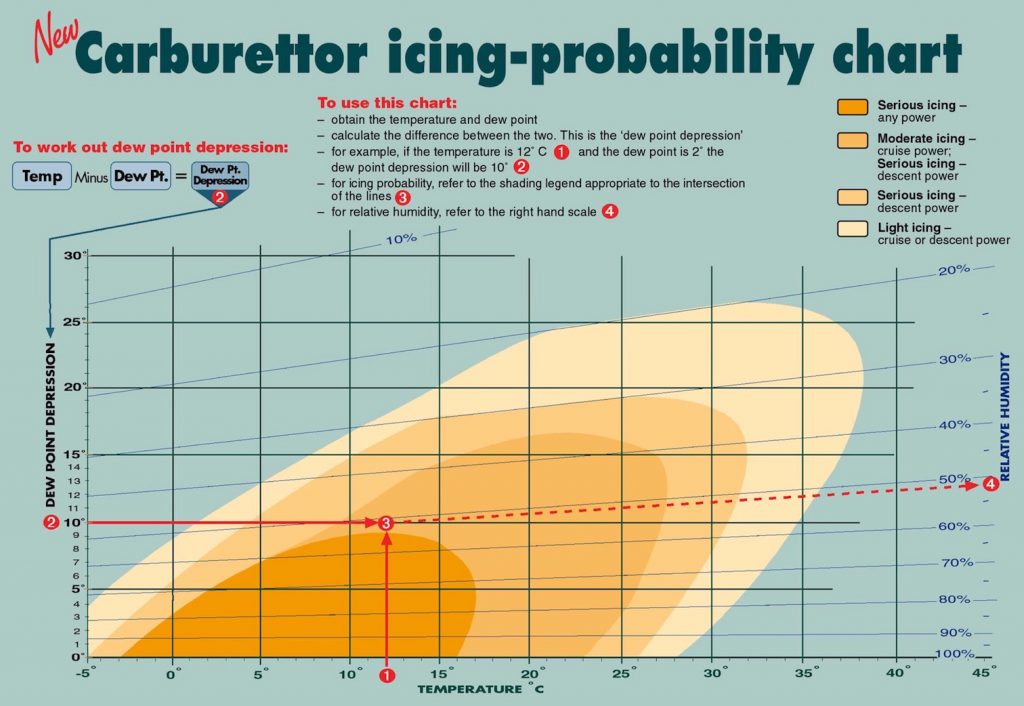
Alaska weather is some of the most conducive weather to carburetor icing.
What is Carburetor Icing and How Do I Know If My Aircraft Is Experiencing Carburetor Icing?
Carburetor icing exists when the moisture inside an engine’s carburetor drops below freezing and water vapor freezes onto the throttle valve and other internal surfaces of the carburetor. The build up of icing inside the carburetor causes a reduction of the fuel/air flow through the carburetor and into the engine. In extreme cases, at reduced power settings, the free movement of the throttle butterfly may be restricted, which will will affect the fuel/air ratio and thereby progressively reduce the flow, eventually choking the engine until is ceases operation.
As carburetor ice forms on the surfaces of the carburetor throat, further restriction takes place, often increasing the Venturi effect initially, but eventually restricting airflow. In severe icing conditions icing can even causing a complete blockage of air to the carburetor. The engine begins to run more rich as ice formation increases and without intervention (carb heat or leaning) this can only continue until the mixture is outside of the functional range for combustion. In very severe scenarios, icing may also cause jamming of the mechanical parts of the carburetor, such as the throttle, typically a butterfly valve.
What Are The Symptoms of Carburetor Icing?
The classic symptoms of carb ice are reduced power and a rough-running engine. In aircraft with fixed pitch propellers, the first indication is typically a small decrease in engine rpm.
Rough Running and Vibration
A carburetor is a calibrated engine component designed to deliver very precise ratios of air and fuel to the engine cylinders. If there is a restriction or blockage, this ratio is negatively affected an the end result is usually a rough running or vibrating engine that is a result of the mixture being too rich or too lean.
Lower EGT
Less air and fuel burned means a lower temperature at the exhaust. Over time and with more experience with your aircraft, you’ll develop an understanding of what is a ‘normal’ range of temperatures. If the EGT is particularly low, carburetor icing is a likely culprit.
Stuck Throttle
In severe cases the butterfly valve in your carburetor can become ‘stuck’.
If the ice builds up significantly, it can ‘freeze’ the throttle in place and restrict any throttle adjustments. Aircraft are particularly prone to this when the throttle has been left in the same position for an extended period of time, such as in the cruise phase of the flight or a long descent. This stuck throttle is often noticed at the beginning of decent when an attempt is made to reduce the power.
Complete Engine Failure!
In extremely rare cases it is possible that the fuel and air mixture can become so out of range that the engine could quit entirely. If this happens, you must select the carb heat to on, as there may be enough residual heat provided from the exhaust manifold to melt the ice.
What Causes Carburetor Icing?
Carburetor icing is the most common of several types of induction system icings. It occurs as a consequence of the sudden drop of temperature caused by the vaporization of the fuel and the pressure reduction in the carburetor venturi. The decline of temperature of up to 20-30 degrees Celsius causes the moisture in the atmosphere to freeze, and the ice will gradually block the venturi tube restricting airflow.
Carburetor icing can occur throughout a wide temperature and humidity range, and is likely at most temperatures that are common in Alaska. The probability of icing depends on both air temperature, relative humidity, engine power and fuel type, though the greatest risk and the most severe icing is found in air temperatures above but near freezing. The probability of icing increases with the relative humidity of the atmosphere. At reduced engine power there is a higher risk of carburetor icing caused by the lower intake temperature and the partly closed throttle valve.
The probability of carburetor icing can be predicted from values of air temperature and dew point depression by use of the below carburetor Icing-Probability Chart (figure 1).

Carburetor icing, or carb icing, is an icing condition which can affect any carburetor under certain atmospheric conditions but the problem is most notable in certain realms of aviation, specifically in atmospheric conditions with low dew point depression (often referred to as the temperature dew point spread), high humidity and temperatures below about 63 degrees F (17 degrees Celsius).
Carburetor icing is caused by the temperature drop in the carburetor, as an effect of fuel vaporization, and the temperature drop associated with the pressure drop in the venturi. The Venturi effect can drop the ambient air temperature by up to 70 absolute degrees Fahrenheit (F) (40 degrees Celsius). In other words, air at an outside temperature of 100 degree F, can drop to as low as 30 degrees F in the carburetor. Carburetor icing can occur when the outside air temperature is as high as 82 degrees F (28 degrees C) and the relative humidity is low as 35 percent, but is most severe at temperatures below 63 degrees F (17 degrees C) and relative humidity greater than 60 percent.
How to Avoid Carburetor Icing
While it applies to all carburetors, carburetor icing is of particular concern in association with piston-powered aircraft, especially small, single-engine, light aircraft. While carburetor ice can be a big concern, there is no need to worry. With a good sense of airmanship and regular checks, the risks from carb icing can be minimized.
Here are the best ways to prevent carburetor icing.
Carb Heat
Aircraft powered by carbureted engines are equipped with carburetor heat systems to overcome the icing problem. In cars, carburetor icing can occasionally be a nuisance. The inlet manifold and parts of the carburetor often have warm water from the cooling system or exhaust gas circulating through them to combat this problem.
Carburetor heat (usually abbreviated to ‘carb heat’) is a system used in automobile and piston-powered light aircraft engines to prevent or clear carburetor icing. It consists of a moveable flap which draws hot air into the engine intake. The air is drawn from the heat stove, a metal plate around the (very hot) exhaust manifold.
Carburetor heat uses hot air drawn from the heat exchanger or heat stove (a metal plate around the exhaust manifold) to raise the temperature in the venturi section high enough to prevent or remove any ice build-up. Because hot air is less dense than cold air, engine power will drop when carburetor heat is used.
Engines equipped with fuel injection do not require carb heat as they are not as prone to icing – the gasoline is injected as a steady stream just upstream of the intake valve, so evaporation occurs as the fuel/air mixture is being drawn into the cylinder, where metal temperatures are higher.
Be Aware of Typical Icing Conditions
Pay attention to the air temperature, humidity and temperature/dew point spread in the areas that you intend to fly. A quick way to determine whether the air is particularly humid is by looking at the dew point. This is the temperature at which water vapor turns into a liquid and condenses. Keep a lookout for a small split (temperature/dew point spread) between the ambient air temperature and the dewpoint when checking the weather. If they are relatively close together, carburetor icing is much more likely.
Fuel Mixture
Remember, fuel evaporation is a cause of carburetor icing. You can reduce the effect of this slightly by flying with a leaner mixture. This isn’t really an option at lower altitudes, however, in cruise flight it is well worth reducing the fuel ratio.
As a nice bonus, leaning the mixture means that you’ll get better range and endurance
High Power
Carb icing is most likely to occur at low power settings, particularly in the descent or during periods of slow flight. The easiest solution in these scenarios is to increase the power occasionally.
In a long descent, you may want to level off for a time and increase the power. A good tip is also to cycle the carb heat while you do this to ensure that there is no ice before continuing on your way down.
Anytime you are in areas that are conducive to carb icing, look for opportunities to give the engine a quick boost of power, along with a cycle of carb heat to burn off any possible carburetor ice.
Conclusion
Carburetor icing is an inherent risk when flying piston-driven aircraft. However, by understanding the causes, we can mitigate that risk. By utilizing onboard systems and following a few standard checks, you’ll be able to ensure your aircraft is operating optimally. Having a good working knowledge of aircraft systems is vital.
Good luck out there! Fly safe!
